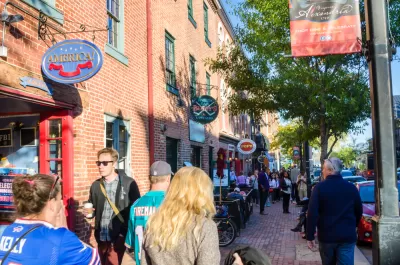When mixed-use development isn’t enough to create vibrant, walkable neighborhoods.

Urbanists make a lot of hay of ‘mixed use,’ writes Erin Caldwell in an op-ed for Next City. Neighborhoods need diverse businesses and services to thrive, urbanists frequently say. But what about the types of businesses?
According to Caldwell, “A neighborhood dense with businesses that do not meet the weekly needs of residents is no better than a neighborhood absent businesses with respect to walkability. Walkability depends, at least in part, on having comprehensive retail.”
For Caldwell, this offers an opportunity for cities to guide development through their zoning codes. “How can cities encourage the presence of businesses that satisfy daily necessities? While zoning based on business type is not new, traditional zoning does not take business usefulness into account. But what if zoning laws allowed useful businesses in residential or mixed-use areas and relegated non-useful businesses to industrial or commercial districts?”
Usefulness is, of course, subjective, so this type of code may be difficult to create and enforce. Caldwell suggests creating objective measures such as the number of in-person transactions or amenities such as public restrooms, bike racks, or public seating. “Besides re-zoning, enrichment through mixed-use can be achieved by permitting business spaces attached to residential units, commonly known as accessory commercial units.”
For Caldwell, retail can have a major impact on community. “Accessible retail and recreation centers are akin to ‘town squares’ in that they provide places and reasons for neighbors to congregate. Repeat visits to businesses increase the likelihood of interaction between neighbors, as well as business staff, who also form an integral part of the community.”
FULL STORY: For Walkable Neighborhoods, We Need More Useful Businesses

Planetizen Federal Action Tracker
A weekly monitor of how Trump’s orders and actions are impacting planners and planning in America.

Congressman Proposes Bill to Rename DC Metro “Trump Train”
The Make Autorail Great Again Act would withhold federal funding to the system until the Washington Metropolitan Area Transit Authority (WMATA), rebrands as the Washington Metropolitan Authority for Greater Access (WMAGA).

The Simple Legislative Tool Transforming Vacant Downtowns
In California, Michigan and Georgia, an easy win is bringing dollars — and delight — back to city centers.

The States Losing Rural Delivery Rooms at an Alarming Pace
In some states, as few as 9% of rural hospitals still deliver babies. As a result, rising pre-term births, no adequate pre-term care and "harrowing" close calls are a growing reality.

The Small South Asian Republic Going all in on EVs
Thanks to one simple policy change less than five years ago, 65% of new cars in this Himalayan country are now electric.

DC Backpedals on Bike Lane Protection, Swaps Barriers for Paint
Citing aesthetic concerns, the city is removing the concrete barriers and flexposts that once separated Arizona Avenue cyclists from motor vehicles.
Urban Design for Planners 1: Software Tools
This six-course series explores essential urban design concepts using open source software and equips planners with the tools they need to participate fully in the urban design process.
Planning for Universal Design
Learn the tools for implementing Universal Design in planning regulations.
Smith Gee Studio
City of Charlotte
City of Camden Redevelopment Agency
City of Astoria
Transportation Research & Education Center (TREC) at Portland State University
US High Speed Rail Association
City of Camden Redevelopment Agency
Municipality of Princeton (NJ)





























